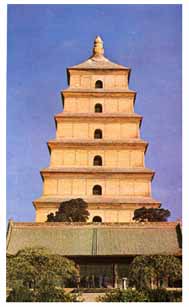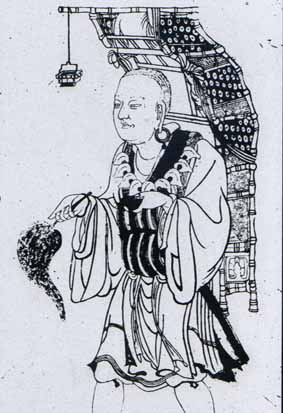| About Us | Site Map | Contact Us |
|
|
| Home | Schools & Teachings | Dharma Centers | Buddha & Bodhisattva Directory | Cosmos |
|
|
The Chinese Buddhist Schools and Teaching
Fa-hsiang school
|
The Indian Yogachara was founded by two brothers, Asanga and Vasubandu, native of North-West India, in the 4th or 5th century. The Asanga and Vasubandu were encyclopaedic systematisers, who developed ideas already established in older writings, such as the Abhidharma, the Prajnaparamita, and the Lankavatara, and gave definitive form to earlier Mahayanist concepts and the theory that reality is consciousness-only. The Chinese Yogachara school was founded by Hsuan-tsang(600-664, Fig. 2), a Chinese pilgrim-translator, and his student Kwei-Ji(638-682), who systematized the teaching. Hsuan-tsang went to India and studied the doctrines derived from Dharmapala (?-507) and taught at the Vijnanavada center in Valabhi. When he returned to China (Fig.1, Great-Goose-Temple, Chan-Yan), he translated Dharmapala's Vijnapti-matratasiddhiand and many other works. His teachings mainly followed the line of Dharmapala. The special characteristics of this school are its emphasis on meditation and a broadly psychological analysis. Fa-hsiang developed a teaching on eight types of consciousness in order to explain the process of ideation (alaya-vijnana). The common view that external things exist is due to an error or misconception that is removable through a meditative process that brings a complete withdrawal or “revulsion” from these fictitious externals and an inner concentration and tranquillity through Yoga practice. Fa-hsiang reduces all of existence to 100 (=8+51+11+24+6) dharmas, which are further divided into five categories: (1). Primary consciousness (vijnana): 8 mental dharmas (cittadharma), comprising
(2). Attendant mental factors (chetasika): 51 mental functions or capacities, dispositions, and activities (caitasika-dharma). (3). Form (rupa): 11 elements concerned with material forms or appearances (rupa-dharma). (4). Dharmas independent of mind: 24 things, situations, and processes not associated with the mind--e.g., time, becoming (cittaviprayuktasmskara) (5). Unconditioned (asamskrita) dharmas: 6 non-created or nonconditioned elements (asamskrta-dharma)--e.g., emptiness or "true suchness"(tathata). The storehouse consciousness is postulated as a receptacle of the imprint of thoughts and deeds, the vasana (literally “perfuming”) of various karmic seeds (bijas). The seeds develop into touch, mental activity, feeling, perception, and will, corresponding to the five skandhas. Then ideation (manas) develops. The process of purifying the subject-object duality and notions of false existence and restored to the pure state of the storehouse consciousness is the only means, according to this school, to achieve the Buddhahood or the undifferentiated state. To address the process in detail, three modes (svabhava) are introduced:
Fully understand the above threefold version of the modes is the correct path to transform consciousness to wisdom. Four types of wisdom can be obtained if the eight primary consciousness(es) (vijnana) can be practiced properly, they are:
These four wisdoms lead the practitioners to four Nirvana:
The forth Nirvana transform the normal body of practitioner into three ultimate Buddha bodies. They are:
|
| About Us | Free Books | Site Map | Contact Us | ||
| Copyright © 1999-2020 Manjushri. All Rights Reserved. | ||

 The Fa-hsiang school is the Chinese continuation of the Indian Yogacara(or Vijnanavada). Fa-hsiang literally means "Characteristic of Dharma". It refers to the central notion of the school, which states that everything is only ideation. This means that the external world is only the product of our consciousness and possesses no reality, they are of the nature of pure Consciousness (vijnana), "consciousness-only" (vijnanamatrata, vijnaptimatrata), or "Mind-only" (Chittamatra). The school thus is referred to as the school of
"Mind-only".
The Fa-hsiang school is the Chinese continuation of the Indian Yogacara(or Vijnanavada). Fa-hsiang literally means "Characteristic of Dharma". It refers to the central notion of the school, which states that everything is only ideation. This means that the external world is only the product of our consciousness and possesses no reality, they are of the nature of pure Consciousness (vijnana), "consciousness-only" (vijnanamatrata, vijnaptimatrata), or "Mind-only" (Chittamatra). The school thus is referred to as the school of
"Mind-only".  The most important book of the school is the Vijnaptimatrata-siddhi (Chin., Cheng-wei-shih-lun, proof of Nothing-but-Cognition) by Hsuan-tsang, a compendious work in which the teaching of the school is presented in detail. The Sandhinirmochana and Lankavatara sutras are also influential in the formulation of the doctrines of Fa-hsiang.
The most important book of the school is the Vijnaptimatrata-siddhi (Chin., Cheng-wei-shih-lun, proof of Nothing-but-Cognition) by Hsuan-tsang, a compendious work in which the teaching of the school is presented in detail. The Sandhinirmochana and Lankavatara sutras are also influential in the formulation of the doctrines of Fa-hsiang.